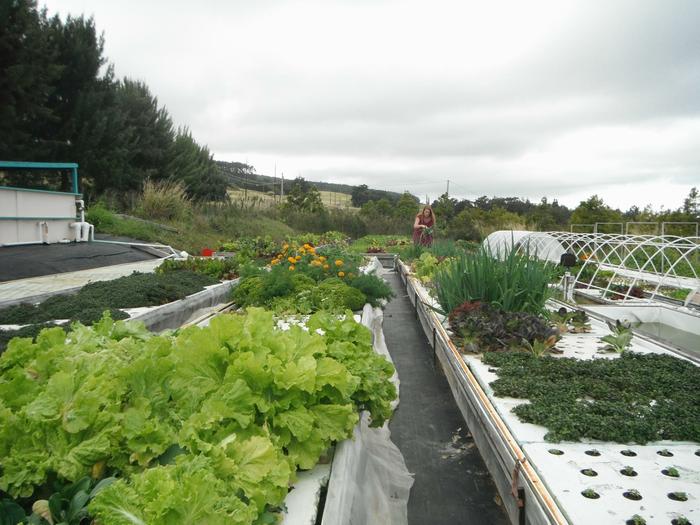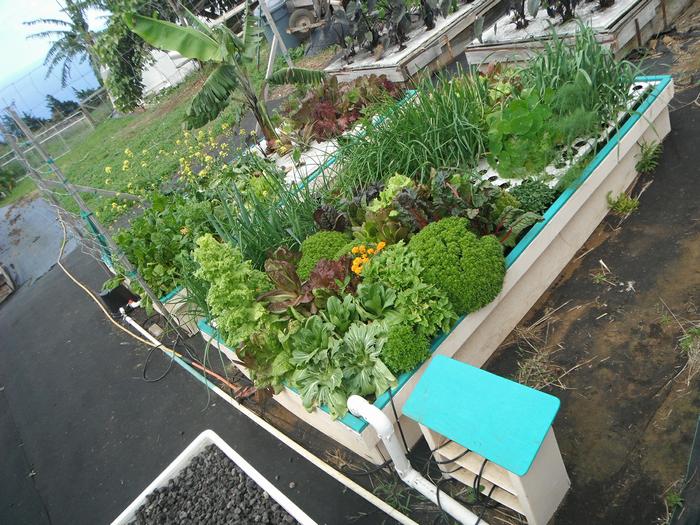The Production Timeline And Getting Off The Ground
If you are planning a commercial aquaponics operation, one of the most important things to plan is your production timeline. You don’t just plant out a 6,000 square foot aquaponics system one week and start harvesting and getting paid for 600 pounds of vegetables per week four weeks later. There are many things you need to do to prepare for this; here are some examples for this approximately 6,000 sq. ft. aquaponics system:
(Below) What’s shown here is only 500 square feet or so; imagine you were responsible for twelve times this amount of aquaponic “real estate”. What do you grow? Will you be able to sell it? Are you ready to go from 0 to 60 in 2.4 seconds? That’s the situation this article addresses. 
1. Build a 64 or 128-square-foot Micro System first thing when you get home from the course, EVEN IF you have the funds and are ready to begin construction on a full-sized commercial system right away. The reasons are that it will be done and operational FAST; and will give you valuable experience QUICKLY in building these systems and operating them. We’ve had students build these inside their garage in the wintertime, and light them with fluorescents; it works just fine!
Having one also lets you discover what grows best in your area QUICKLY, as this varies widely in sites as little as a few miles apart due to variations in microclimate. You can do a test planting in a MicroSystem’s 408 or 816 pot spaces of tens of different varieties of vegetables, then you’ll KNOW what grows best without having to wait for when you first plant out your $100,000 commercial system. The MicroSystem will also give you produce to do test marketing with; I’d hate to grow a lot of something in my big commercial system only to find the market was already oversupplied with it, or that it brought such a low price I couldn’t make money on it. Test marketing is one of the most important things you can do on your way up the mountain; it is just as important as getting your big aquaponic system built and operating, remember to do both!
You do not want to learn to drive in a loaded 18-wheeler going downhill at night in the rain! You want to start on a sunny day in a Toyota Corolla with an automatic transmission! In the same way, you do not want to learn how to “drive” in a 20,000-square-foot aquaponics system with a $4,500/month loan payment and $8,000 per month of overhead expenses! It’s got way too much inertia and way too many “moving parts”. But this is the way all the failures in our “Aquaponics Failures” PowerPoint slideshow started (click on the blue underlined text to download this free slideshow). The moral of the story? Even for someone who plans to go “big time”, it’s smart to start small.
(Below) A cute little 64-square-foot Micro System: much easier to learn how to drive on!
2. Build your main commercial system(s) while becoming experienced and confident with aquaponics by operating your MicroSystem and test marketing the vegetables from it. This way, you won’t be a complete newbie when you start growing things in the system that has a mortgage on it! Finish your big system and inoculate it with water from your MicroSystem, then start planting the species in it that grew well in your test plantings and did well in your test marketing from your MicroSystem.
3. Ramp up slowly to full production, don’t plant the entire system out at once in one crop. We ran on lettuce only for two years, then had a devastating lettuce blight hit us (and many other lettuce farmers on the island) that destroyed all the lettuce plants in our systems in a few weeks. This was a good lesson about the dangers of mono-cropping (growing only one thing, over and over); it lets you in for massive plant disease episodes that can be catastrophic to your operation. Increasing production slowly will allow you to gain experience with seeding, transferring pots, feeding fish, harvesting and packaging vegetables, and all the other details that are needed to operate smoothly and with minimum labor requirements in order to be a profitable business.
4. If you don’t ramp up slowly, you run the risk of implementing a process or procedure that is inefficient; and at full production, this can cost you badly as you are forced to do it over and over again. You have far less flexibility about changing direction when you are in full production; you won’t have the time or energy to try out new things. If you do find a successful one you want to implement, it will be more difficult to change direction when your operation is going under full momentum because of the “mass” involved. You also run the risk of missing a discovery that could have made all the difference to you and your business, e.g.: discovering that growing “this” instead of “that” requires less labor and “this” sells for more; or “this”, combined with something else makes a killer value-added product that makes a ton of money for you (such as a basil pesto made from your aquaponic basil plus some organic olive oil and mac nuts).
5. You may need to use temporary measures and markets to move produce at less than full value before you are at full operating capacity. For example, you might have 40 to 80 pounds a week coming from your first planting; give this away to your potential customers for additional market testing and to develop a good customer relationship. Next you’ll have 120 to 150 pounds per week; give this away, and/or take to farmer’s market to sell it yourself, and/or find someone already selling at the farmer’s market to sell this for you, and/or sell to a restaurant(s) or hotel(s). If these are good accounts you enjoy selling to, you may decide to keep them rather than use them as a stepping-stone.
6. Next, you’ll have a couple of hundred pounds a week coming out; at this point you may be able to get a produce distributor, wholesaler, or large grocery store willing to buy this from you. If this is a good account you enjoy selling to, you may decide to continue this rather than use it as a stepping-stone. If you’ve already got some good accounts from step 5 previously, you may now have a significant percentage of your ultimate production spoken for. We’ve seen people do this several times: plan to sell to an “ultimate” market, and instead find other quite acceptable outlets for their produce on the way. These other outlets ended up taking all the farm’s production, and the “ultimate” outlet wasn’t even necessary.
7. At your final production level, depending on species and varieties grown, you may have from 500-1,000 pounds per week production from this 6,000-square-foot example system. This can be all one species, as in our lettuce production heyday, but then you are risking a massively devastating disease incident that can occur due to this kind of mono-cropping. If you have this production split up between three or four vegetable varieties (or even better, ten, twelve, or twenty), you have less chance of such a disease incident. You also have a much more flexible mix of product, and a more guaranteed income due to your system’s diversification. If you have a disease, a problem, or a change in the market conditions or buyer that apply to one vegetable, you still have three (or ten) others that continue creating income for you.
8. We have only talked about the vegetables so far; you will also have fish to sell. Because we lose $2/pound on fish on our farm due to high fish food and electricity costs, we just raise the fish necessary to provide fertilizer for the vegetables. A common problem when an aquaponics operation starts up is procuring enough (by weight) fish (or ANY!). You ultimately need 1,800 pounds of fish to run this 6,000 square foot system; you probably WON’T be able to just go out and buy them. Based on our experience, you will be able to procure 1-2,000 little fish (+/- 3 oz. or so), which will just barely fertilize your system if you stuff them full of food three times a day. However, they will eventually grow to weigh a pound, then a pound and a half, and you will have 3,000 pounds of fish instead of the 1,800 you actually need. You’ll have fish to sell. But they will grow slowly, and you will have plenty of warning to start telling people you have LIVE tilapia to sell from your farm. Advertise to the right ethnic groups, and you will have people calling YOU and asking if you have live fish to sell.
Would like to know your best advise to start a smll backyard system to learn and grow to a larger system some day. At this point I would just like to have a minimal investment and grow enough vegtable based produce to feed my family. There is so much info on your site and the web, I am hoping you have a “bundeled kit” of instructions, plans, materials etc that I could use to start my small backyard system.
Thank you for your time and I look forward to your reply!
-Steve
Hi Steve!
Thanks for asking! It’s not my site and I suspect you e-mailed me accidentally. Nevertheless, I will tell you of my experience. I started by purchasing a small plastic bin used found in the cement section of the local Home Depot store. I then bought a small aquarium (about 1 gallon), bought fish, plumbed it and built it out according to the Friendly Aquaponics’ methodology. This was my proof of concept prototype. This worked very well. You can build this with a minimum of investment.
After you have proved this to yourself, you will have a good idea of how to build a much bigger aquaponics garden. I suggest you purchase instructions for the backyard garden manual from Friendly Aquaponics. The information in the manual provides much information from which you can build what you’re describing. But an even greater value is the support you receive from the folks at Friendly Aquaponics!
I wish you the best of luck in you aquaponics adventure!
Hi Steve,
The small backyard system is called a Microsystem. It comes with complete plans for the 64 square foot and 128 square foot systems so it will grow with you as your needs change. This is the system I started with and it is a step by step guide that walks you through every step.
Here is the link to the product page- http://old.friendlyaquaponics.com/product/micro-system-64-and-128/
Best of luck with your veggies =)
-Jess
Fixed it; thanks!